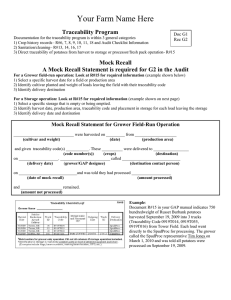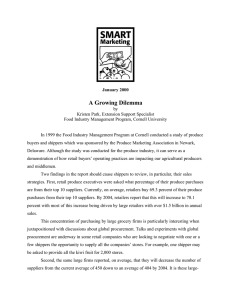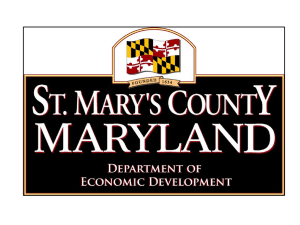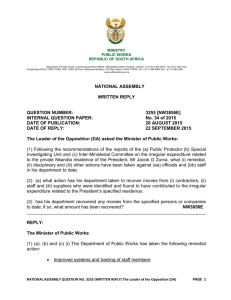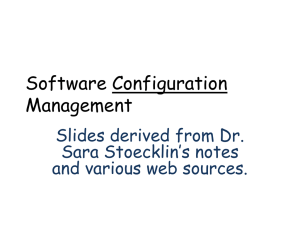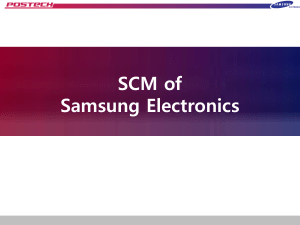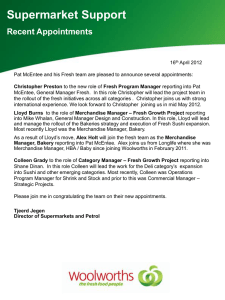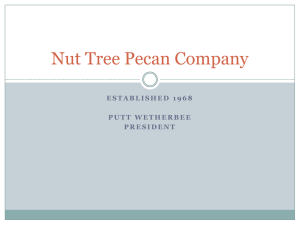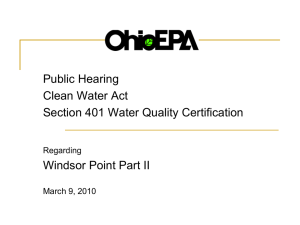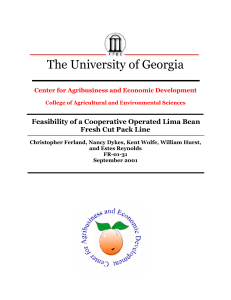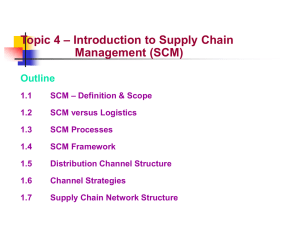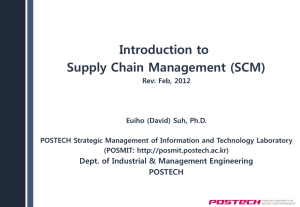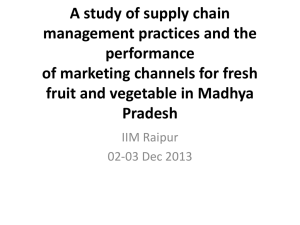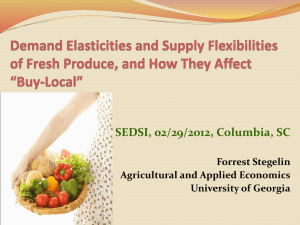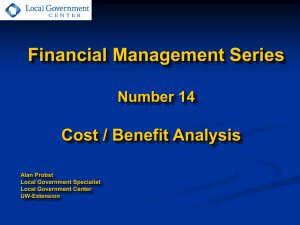Structural Shifts Affecting The Supply Chain in Fresh Produce
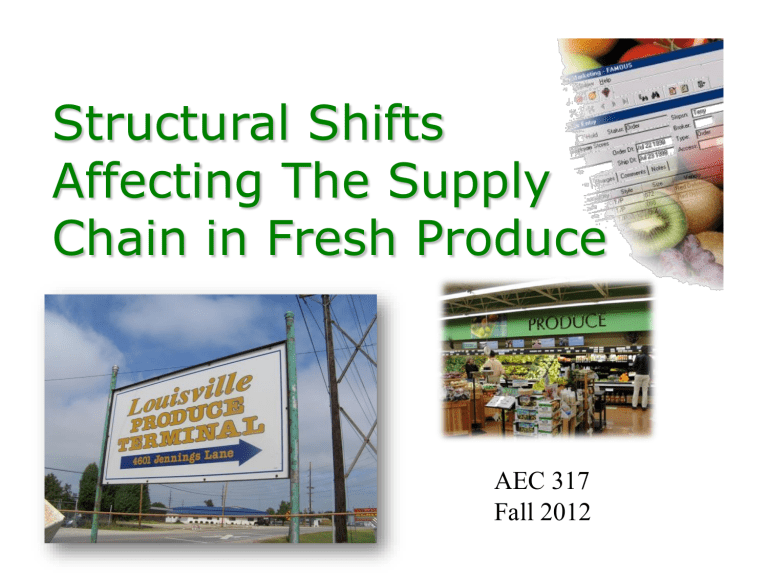
Structural Shifts
Affecting The Supply
Chain in Fresh Produce
AEC 317
Fall 2012
Increases in vegetable consumption
Source: Vegetable & Melons Situation and Outlook, ERS, 2012
1992-2002 Produce Acreage Changes
(thousand acres)
+105
-25
+823
+3
-28
-7
+11
0
0
-9
-7
0
+1
+2
0
+34
-57
-9
-92
-50
-5
+17
-30 +2
0
-11
-5
0
+5
-2
-2 -11
+45
-13
-1
-1
-2
-9
-12
0
-6
-5
0
-4
-2
+5
-24
1 to +10,000 acres gain
11,00 to 45,000 acres gain
Source: USDA Census of Agriculture 1992 –
2002
-69
Produce Acres in U.S.
Increase in Marketing Formats
• Farmers Markets
• Organic and Health Food Stores
– Whole Foods (Wild Oats), Fresh Market, and other natural foods merchandisers
• Convenience Stores
• Club Stores
• Conventional Supermarket
• Even fast food moving strongly toward distributing more produce
Fresh Fruit and Vegetable Marketing Channels
2007 - $5.0
2007 -$20.5
- - -
Supervalu
Fleming
+ + +
Castellini
Sysco
Alliant, GFS
2000 - $75.8
2007 - $100
2007 - $9.0
Net trade of Fresh Fruit and Vegetables
8
Terminal Markets
Louisville Terminal Market
Terminal Markets
Diminish in importance
Fierce competition places multiple demands on produce suppliers while perishability limits power!
Retail consolidation
Fewer buyers
Oversupply
Specific buyer requirements:
• packaging
• palletizing
• JIT delivery
• traceability
• temperature
• shelf life
• safety
• consistency
• volume
Factors Driving Scale Economies
• On-Farm production technology
• Distribution economies
• Buyer scale – (imposing supplier standards)
• Food safety and quality demands
Grower/Shipper Responses to Influence Price
Expand control – horizontally or vertically
• Consolidate horizontally: acquire, merge, or form alliances with other grower/shippers to become multi-regional or multicommodity shippers
• Coordinate vertically: newly forged “partnerships” between produce shippers and retailers, even in the form of contracts.
Grower/Shipper Responses to Influence Price
Adopt differentiation strategies
• Adopt cost-reducing technologies that also affect marketing (e.g. plasticulture)
• New hybrids/varieties/crops
(e.g. maroon carrot)
• Specialized products/forms
(fresh processed; value added products)
• New packaging schemes & POP
• Undertake demand expansion programs
(including alternative market windows)
Defining SCM
• SCM – a continuous channel-level management process of shaping and reshaping intracompany performance, information technology tools, products and services, and organization to meet emerging customer opportunities
– D. Ross, Competing Through Supply Chain
Management
Defining SCM
• Never totally attained
• Unique chain strategies - What works in one chain does not necessarily work in another
Supplier Enterprise
Channel Network Programs
Inventory Planning
Production Management
Purchasing
Customer Service
Transportation
Warehousing
Customer Enterprise
Defining SCM
• Coordination with a view toward…..
– Creating customer value
– Total focus on continuous improvement
– Formalization of quality processes
– Development of quality process methods
– Developing effective performance methods
Why SCM for Horticulture Sector?
• Large retail networks with their own distribution centers
• Chain-wide quality assurance requirements
• International sourcing
• Efficient Consumer
Response initiatives from the packaged food manufacturer
• Increases in SKU’s
Retail Produce SKUs
700
600
500
400
300
200
100
0
19
60
19
70
19
80
19
90
19
94
19
99
20
06
Some Supply Management Factors
Produce Shrinkage
4
3
2
1
0
8
7
6
5
0.9
6.1
Warehouse Retail Store
7
Total
Role of Electronic Technology
• Electronic data interchange
• Cross docking
• Case coding
• Continuous replenishment
• Vendor-managed inventory
Shared responsibilities
• Retailers and growers expect to see significant sharing in responsibilities
– Promotion support/planning
– Demand forecasting
– Inventory management
– Category management
– Cross docking and other functions
System wide supply chain priorities
Issue
Food safety
Quality specifications
Cold chain maintenance
HACCP standards
Inventory turns
Vendor partnerships
Product traceability
Decreased order time
E-commerce
VMI
Flow through/cross dock
Percent of participants rating issue as a high priority
Retailer Grower/shipper
100.0
100.0
100.0
97.5
95.0
90.0
87.5
60.0
52.5
42.5
45.0
90.9
95.5
77.2
81.8
70.0
91.0
95.5
61.9
86.4
86.4
60.0
Source: Perisio, et al., 2001
Preferred Supplier
Attributes
1. Consistent quality (aesthetics & shelf life)
2. Consistent on-time delivery (JIT).
3. Consistent volume (supplies sufficient to fill majority of stores in a “region”).
4. Price protection on rising markets.
5. PLU/UPC/COOL labeling or coding capabilities (traceability).

